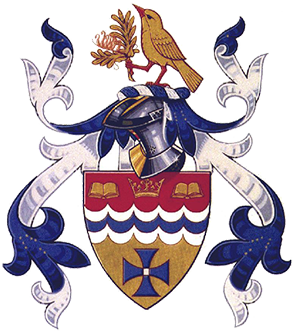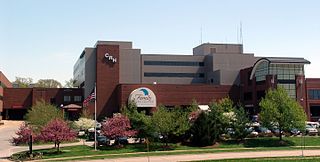
Pediatric nursing is part of the nursing profession, specifically revolving around the care of neonates and children up to adolescence. The word, pediatrics, comes from the Greek words 'paedia' (child) and 'iatrike' (physician). 'Paediatrics' is the British/Australian spelling, while 'pediatrics' is the American spelling.

King Edward Memorial Hospital for Women (KEMH) is a hospital located in Subiaco, Western Australia. It is Western Australia's largest maternity hospital and only referral centre for complex pregnancies.

Blacktown Hospital is a university teaching hospital in Blacktown, New South Wales, Australia, about 34 kilometres from the Sydney CBD. Together with Mount Druitt Hospital and associated community health centres, it is a part of the Western Sydney Local Health District (WSLHD). The hospital is located in one of the fastest population growth areas in NSW, caring for patients from highly diverse cultural and social-economic status backgrounds.

The Royal North Shore Hospital (RNSH) is a major public teaching hospital in Sydney, Australia, located in the suburb of St Leonards. It serves as a teaching hospital for Sydney Medical School at the University of Sydney, University of Technology Sydney and Australian Catholic University and has over 600 beds.

Vancouver Hospital and Health Sciences Centre (VHHSC) is an acute care hospital affiliated with the University of British Columbia and located in Vancouver, British Columbia. The VHHSC is the second largest hospital in Canada, with 1,900 beds and nearly 116,000 patients each year. VHHSC employs 9500 staff and utilizes 1000 volunteers. As of 2005, the hospital's annual budget is $463 million. It is managed by Vancouver Coastal Health.

NETS is an acronym for newborn emergency transport service orsystem. Such services provide critical care transport for newborn babies requiring care not available in the hospital of birth. Some provide other services; such as outreach education, return transport and coordination of high-risk obstetric transfer. Others provide transport services in older age-groups.

Montreal Children's Hospital is a children's hospital in Montreal, Quebec, Canada. Founded in 1904, it is affiliated with the McGill University Health Centre (MUHC) and McGill University, Faculty of Medicine.

Adventist HealthCare Shady Grove Medical Center is a 266-licensed bed acute care facility located in Rockville, Maryland. Shady Grove Medical Center provides a range of health services to the community such as high-risk obstetrical care, cardiac and vascular care, oncology services, orthopedic care, surgical services and pediatric care. Opened in 1979 as Shady Grove Adventist Hospital, Shady Grove Medical Center operates as part of Adventist HealthCare, a health-care delivery system that includes hospitals, home health agencies and other health-care services. Adventist HealthCare is headquartered in Gaithersburg, Maryland.

Auckland City Hospital is a public hospital located in Grafton, Auckland, New Zealand. It is the largest hospital in New Zealand, as well as one of the oldest medical facilities in the country. It provides a total of 1,165 beds. It was established in 2003 as an amalgam of Auckland Hospital, Starship Hospital, Green Lane Hospital and National Women's Hospital. Public hospitals in Auckland have been run by Te Whatu Ora – Health New Zealand since 2022.

Surrey Memorial Hospital (SMH) is a publicly funded hospital owned and operated by Fraser Health in the city of Surrey, British Columbia, Canada, adjacent to King George Boulevard.

British Columbia Children's Hospital is a medical facility located in Vancouver, British Columbia, and is an agency of the Provincial Health Services Authority. It specializes in health care for patients from birth to 16 years of age. It is also a teaching and research facility for children's medicine. The hospital includes the Sunny Hill Health Centre, which provides specialized services to children and youth with developmental disabilities aged birth to 16 years.

University of Missouri Health Care is an American academic health system located in Columbia, Missouri. It's owned by the University of Missouri System. University of Missouri Health System includes five hospitals: University Hospital, Ellis Fischel Cancer Center, Missouri Orthopedic Institute and University of Missouri Women's and Children's Hospital — all of which are located in Columbia. It's affiliated with Capital Region Medical Center in Jefferson City, Missouri. It also includes more than 60 primary and specialty-care clinics and the University Physicians medical group.

The University of Missouri Women's Hospital, formerly University of Missouri Women's Hospital, is the only hospital in Missouri exclusively dedicated to the health of women. The hospital was formerly home to MU Children's Hospital, and is currently home to MU Women's Center, and the Family Birth Center. The Women's Hospital no longer has a pediatric Emergency Room and inpatient services, having moved to University Hospital. In Fiscal Year 2009, 1,793 babies were born in the Family Birth Center. The hospital has the da Vinci minimally invasive surgical robotic system. It is located in eastern Columbia near the interchange of Interstate 70 and U.S. 63 at 404 North Keene Street.

Neonatal nursing is a sub-specialty of nursing care for newborn infants up to 28 days after birth. The term neonatal comes from neo, "new", and natal, "pertaining to birth or origin". Neonatal nursing requires a high degree of skill, dedication and emotional strength as they care for newborn infants with a range of problems. These problems vary between prematurity, birth defects, infection, cardiac malformations and surgical issues. Neonatal nurses are a vital part of the neonatal care team and are required to know basic newborn resuscitation, be able to control the newborn's temperature and know how to initiate cardiopulmonary and pulse oximetry monitoring. Most neonatal nurses care for infants from the time of birth until they are discharged from the hospital.

Rainbow Babies & Children's Hospital is a pediatric acute care children's teaching hospital located in Cleveland, Ohio. It is affiliated with Case Western Reserve University School of Medicine and has a neonatal intensive care unit (NICU), pediatric intensive care unit (PICU), and level 1 pediatric trauma center.
Spartanburg Regional Healthcare System(SRHS) is one of South Carolina's largest healthcare systems. SRHS draws patients primarily from the areas of Spartanburg, Cherokee, Union, and Greenville counties (all located in the Piedmont region of South Carolina), as well as Rutherford and Polk counties (located in western North Carolina). Spartanburg General Hospital was organized under the authority of the South Carolina General Assembly in 1917. It officially became the Spartanburg Regional Health Services District, Inc., a political subdivision of the State of South Carolina, by the charter granted by the Secretary of State of South Carolina on May 1, 1995.
Richmond Hospital (RH) is a general hospital in Richmond, British Columbia, Canada. The Vancouver Coastal Health Authority (VCH) is responsible for Richmond Health Services and Richmond Hospital.

Henry Mayo Newhall Hospital is a 357-bed not-for-profit community hospital and trauma center in Valencia, Santa Clarita, California. It was founded in 1975. Named after businessman Henry Mayo Newhall, the hospital recently opened a new patient tower that includes 90 private patient rooms and a new Center for Women and Newborns, also with all private rooms.

Royal Columbian Hospital (RCH) is among the oldest hospitals in British Columbia and one of the busiest in the Fraser Health Authority. It is located in New Westminster overlooking the Fraser River and is the only hospital in the Lower Mainland that is immediately adjacent to a Skytrain station (Sapperton).

Excela Health is a not-for-profit health organization that includes three licensed, acute care hospitals, two free-standing outpatient surgery centers, home care and hospice, physician practices, a durable medical equipment company and other facilities and services. Formally incorporated in 2004, Excela Health is governed by a single Board of Trustees. Its headquarters is located in Greensburg, Pennsylvania.




















